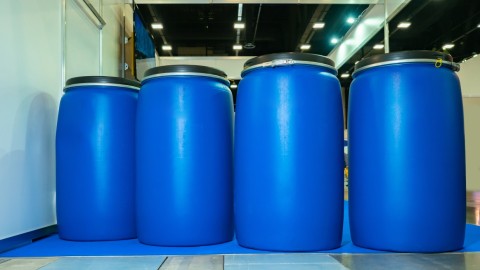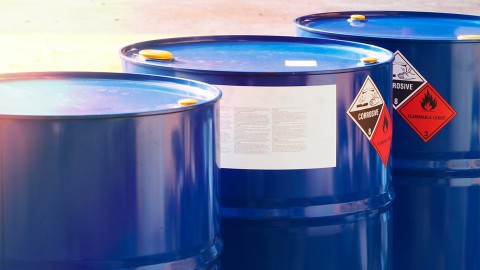Risk assessment for hazardous substances
Airborne hazardous substances at the workplace can have severe health consequences for you and your workforce. That is why the risk has to be regularly measured or otherwise assessed. In this article, we use manufacturing employees as an example because they often work with hazardous substances. Read more to learn how to make your workplace safe and secure.
Risk assessment at my plant
Working out health and safety measures for a company is a big responsibility. To do it properly, it is important to consult with experts on hazardous substances. They can provide valuable insights: for example, always use the smallest possible quantity or the standard lab quantity when working in a production facility or pilot plant; always store chemicals safely; always use tools and equipment correctly. All legal standards should be followed as well, including the German Hazardous Substances Regulation (GefStoffV) or the related Technical Rules on Hazardous Substances (TRSG).
Learn more about hazardous substances at the workplace here.
A company or laboratory director might be wondering:
Are risk assessments really required?
Answer: Yes. All companies or laboratories have to undergo a risk assessment. The risk assessments required by the Occupational Safety and Health Act (ArbSchG) take precedence, followed by more detailed information on inhalation, dermal and fire/explosion hazards for activities involving hazardous substances as necessary.
Is this a mandatory order for the site?
Answer: This is a legal requirement and, only in some cases, a commitment for the park. Regulators can require that a risk assessment be performed.
Can any areas be left out?
Answer: No. The risk assessment must cover every area in which non-trivial types and quantities, i.e. not household types and quantities, of hazardous substances are handled.
Do measurements absolutely have to be taken in the plant or laboratory?
Answer: No. Plant or laboratory measurements are only required if it is not clear whether the occupational exposure limit values are being met, for example, when there is no fume extractor present, or if you want to verify a fume extractor’s effectiveness when handling highly volatile solvents or doing work that causes dust.
Who can take workplace measurements?
Answer: Companies are responsible for measuring the concentration of airborne hazardous substances at the workplace. Companies can outsource the measurement tasks if they lack the staff or other resources to do the work in-house. However, they should only outsource the work to reliable service providers. An accredited measuring station can perform all the required activities (determination, monitoring, documentation). Accrediting body Deutsche Akkreditierungsstelle (DAkkS) lists all accredited measuring stations on its website.
Laboratory risk assessments are done regularly and involve the following steps:
Many companies lack deep expertise on classification, labeling and risk assessment for activities involving hazardous substances. In short, they urgently need to do something!
- Initial talks
- On-site inspection
- Observations
- Assessment
- Customization of safety measures
- Findings
- Documentation and archiving
- Risk assessment with action plan
Specific risk assessments must be performed at the production plant, laboratory or warehouse because every workplace is different and harbors its own potential hazards. A customized risk assessment simplifies the entire process and reduces liability.
Substance identifications and assessments consist of the following steps (illustrated by a fictitious example):
- Type of activity (filling)
- Chemical agent (acetone)
- Area (laboratory)
- State (liquid)
- Volume used (300 ml)
- Frequency (25x per year)
- Duration of activity (½ hour)
- Occupational exposure limit value (1,200 mg/m³ air pursuant to TRGS 900)
- Precautions taken (hood, protective gloves, safety glasses)
- Verification of precaution effectiveness (regular testing or repair)
Exposure registers based on risk assessments
When is a substance considered hazardous? It depends on its physical, chemical, toxicological and ecotoxicological attributes. Hazardousness is also affected by phase (solid, liquid or gas), concentration and equipment type. Hazardous substances are organized into categories that provide information about the risk they pose. Higher categories pose smaller hazards; lower categories, larger threats. For example, Category 1 toxic substances are life-threatening even in low concentrations.
TRGS 410 or German Hazardous Substances Regulation (GefStoffV) § 14 requires an exposure register to be maintained wherever employees are exposed to Categories 1A and 1B carcinogenic, mutagenic or reprotoxic substances.
Occupational physicians, government officials, employee representatives and safety managers at the company must have access to the register at all times. In addition, employees must be given an extract from the register about themselves and their workplace on request or upon leaving the company.
However, exposure registers cannot be drawn up without prior risk assessments, which would leave employees without any information about the safety of their workplace. That makes the risk assessment one of the most important aspects of ensuring employee health and safety, alongside measuring hazardous substances and providing expert advice.




